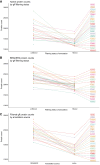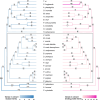Genome-Wide Gene Birth-Death Dynamics Are Associated with Diet Breadth Variation in Lepidoptera
- PMID: 38976568
- PMCID: PMC11229701
- DOI: 10.1093/gbe/evae095
Genome-Wide Gene Birth-Death Dynamics Are Associated with Diet Breadth Variation in Lepidoptera
Abstract
Comparative analyses of gene birth-death dynamics have the potential to reveal gene families that played an important role in the evolution of morphological, behavioral, or physiological variation. Here, we used whole genomes of 30 species of butterflies and moths to identify gene birth-death dynamics among the Lepidoptera that are associated with specialist or generalist feeding strategies. Our work advances this field using a uniform set of annotated proteins for all genomes, investigating associations while correcting for phylogeny, and assessing all gene families rather than a priori subsets. We discovered that the sizes of several important gene families (e.g. those associated with pesticide resistance, xenobiotic detoxification, and/or protein digestion) are significantly correlated with diet breadth. We also found 22 gene families showing significant shifts in gene birth-death dynamics at the butterfly (Papilionoidea) crown node, the most notable of which was a family of pheromone receptors that underwent a contraction potentially linked with a shift to visual-based mate recognition. Our findings highlight the importance of uniform annotations, phylogenetic corrections, and unbiased gene family analyses in generating a list of candidate genes that warrant further exploration.
Keywords: Lepidoptera; butterflies; coevolution; comparative genomics; diet breadth; gene birth–death dynamics; insect–host plant interactions; specialization.
© The Author(s) 2024. Published by Oxford University Press on behalf of Society for Molecular Biology and Evolution.
Figures




Similar articles
-
The Lepidoptera Odorant Binding Protein gene family: Gene gain and loss within the GOBP/PBP complex of moths and butterflies.Insect Biochem Mol Biol. 2015 Jul;62:142-53. doi: 10.1016/j.ibmb.2015.03.003. Epub 2015 Mar 14. Insect Biochem Mol Biol. 2015. PMID: 25784631
-
Expanding the Menu: Are Polyphagy and Gene Family Expansions Linked across Lepidoptera?Genome Biol Evol. 2022 Jan 4;14(1):evab283. doi: 10.1093/gbe/evab283. Genome Biol Evol. 2022. PMID: 34951642 Free PMC article.
-
Phylogenomics provides strong evidence for relationships of butterflies and moths.Proc Biol Sci. 2014 Aug 7;281(1788):20140970. doi: 10.1098/rspb.2014.0970. Proc Biol Sci. 2014. PMID: 24966318 Free PMC article.
-
Lepidoptera genomes: current knowledge, gaps and future directions.Curr Opin Insect Sci. 2018 Feb;25:99-105. doi: 10.1016/j.cois.2017.12.004. Epub 2017 Dec 23. Curr Opin Insect Sci. 2018. PMID: 29602369 Review.
-
Ecology and evolution of cycad-feeding Lepidoptera.Ecol Lett. 2020 Dec;23(12):1862-1877. doi: 10.1111/ele.13581. Epub 2020 Sep 24. Ecol Lett. 2020. PMID: 32969575 Review.
Cited by
-
Phylogenomics of the Ecdysteroid Kinase-like (EcKL) Gene Family in Insects Highlights Roles in Both Steroid Hormone Metabolism and Detoxification.Genome Biol Evol. 2024 Feb 1;16(2):evae019. doi: 10.1093/gbe/evae019. Genome Biol Evol. 2024. PMID: 38291829 Free PMC article.
-
Identification and expression of detoxification genes provide insights into host adaptation of the walnut pest Atrijuglans aristata.BMC Genomics. 2025 Apr 18;26(1):387. doi: 10.1186/s12864-025-11524-x. BMC Genomics. 2025. PMID: 40251474 Free PMC article.
References
MeSH terms
Grants and funding
LinkOut - more resources
Full Text Sources

